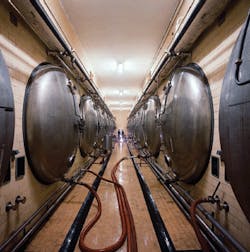If properly selected, pin-and-sleeve devices can cure some common installation problems.
Pin-and-sleeve devices are often the first choice for high-quality, secure electrical connections in high-abuse environments. They are well-suited to supplying power equipment like welders, motor gen-sets, compressors, conveyors, portable tools, and portable lighting. They are especially appropriate for matching high-current power sources to the correct equipment and integrating switched and fused interlock receptacles in wet or corrosive environments (Photo).
There are several types of pin-and-sleeve devices, and among them are older, metal-housed products; various nonstandard plastic products not compatible with other vendors' products; and the newer International Electrotechnical Commission (IEC) 309 standardized products. IEC 309-compliant products meet global standards regardless of the manufacturer, ensuring compatibility between products. They are the exception, however, and nonstandardized devices can vary greatly in design, so you need to do some research when specifying and purchasing them. Does the device have funneled, or tapered, wiring pockets? Are the screw heads on the same side? Do the plugs and connectors have wrenching surfaces on the back housing? Do the mechanical interlocked receptacles fit between the webs of an I-beam? The presence of any or all of these features will add to the ease of installation and improve reliability.
IEC 309 specifies the technical requirements for pin-and-sleeve products, but the IEC doesn't test products to see if they meet the standard — this is up to national testing organizations. As a result of recent trade agreements, either Underwriters Laboratory (UL) or Canadian Standards Association (CSA) can test a product for one or both countries. Pin-and-sleeve devices are commonly tested to, and meet, various plug and receptacle certifications and compliances, including UL 498, 1682, and 1686; CSA standard C22.2 No.1821; IEC 300-1/2; NEMA 4X; IEC IP66 housing; and VØ flame rating.
Pin-and-sleeve variations.
You can also specify splashproof or watertight pin-and-sleeve products. Splashproof versions are less expensive than watertight models, and you might use them when environmental requirements are less critical. The IEC standards specify product environmental ratings using an ingress protection (IP) rating (Table on page 36). Watertight devices typically carry an IP rating of 66, and splashproof devices normally carry an IP rating of 44. The first number of the IP rating refers to dust protection, and the second number refers to water protection. For instance, a 6 for dust protection indicates a fully dust-tight rating, and a 4 refers to protection against all dust particles larger than 0.1 mm. A 6 for water protection refers to protection against power sprays, and a 4 refers to protection against splashed water.
The IEC 309 standard specifies five devices: plugs, connectors, receptacles, inlets, and mechanically interlocked receptacles. The first four are used in almost every electrical distribution system, but interlocked receptacles are not as common. Mechanically interlocked receptacles are designed to prevent the insertion or removal of the plug from the receptacle while powered. This receptacle is equipped with a switch on the outside of its enclosure that allows power to be turned on and off. If the plug is inserted in the receptacle, the switch will be mechanically interlocked with the receptacle so the plug cannot be removed until the switch is turned off.
You can also purchase interlocked receptacles with internal fusing for additional functionality. Fused, mechanical interlocked receptacles provide overload protection in an enclosure in addition to an interlocked switch.
A clocking system defined in IEC 309 prevents mating of products of different configurations. The system defines the location of the ground pin relative to the keyway on the outside of the plug or connector. The locations of the grounding and conducting pins are rotated to a different clock position for each voltage configuration.
Terminations and seals.
Today, you can disassemble most plugs and connectors by loosening two screws. Wiring terminations normally have funneled channels to allow easy separation and insertion of the wires, which prevents individual strands of the wire from shorting between conductors. Large terminal screws provide a reliable connection and ease the tightening of the terminations. Many suppliers place all the terminal screws on the same side of the plug or connector to eliminate the need to rotate the device while tightening the screws.
The watertight seals are easy to size. Many suppliers provide a design that allows you to remove the seal in layers to fit the size of the wire used in the application. Tightening the seal is easy because most products have threaded pieces that tighten down on the seals. These products often have cord clamps and strain relief both internally and externally.
So, the next time you're installing electrical equipment in a wet, dirty, or corrosive environment, be sure to use an appropriate pin-and-sleeve device. Not only will it improve the reliability of the power system, but it will also make it last for years to come.
Hansen is technical product manager, Cooper Wiring Devices, Long Island, N.Y.
